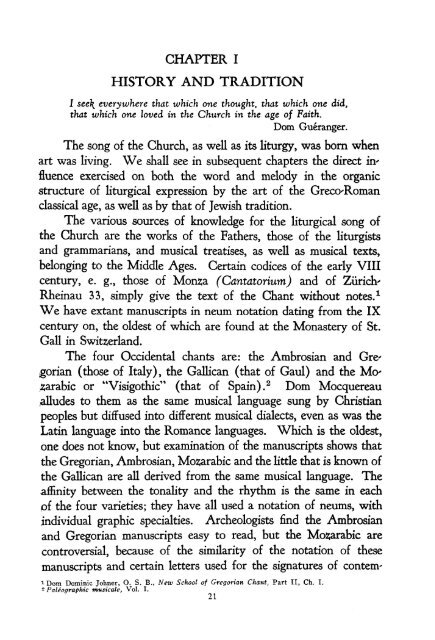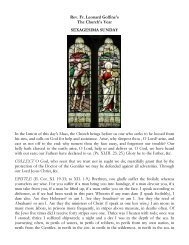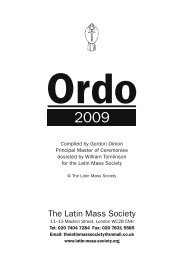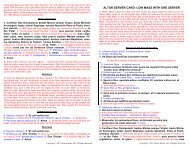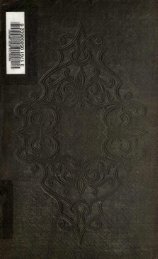The Spirit of Gregorian Chant - Church Music Association of America
The Spirit of Gregorian Chant - Church Music Association of America
The Spirit of Gregorian Chant - Church Music Association of America
You also want an ePaper? Increase the reach of your titles
YUMPU automatically turns print PDFs into web optimized ePapers that Google loves.
CHAPTER I<br />
HISTORY AND TRADITION<br />
I see\ everywhere that which one thought, that which one did,<br />
that which one loved in the <strong>Church</strong> in the age <strong>of</strong> Faith.<br />
Dom Gueranger.<br />
<strong>The</strong> song <strong>of</strong> the <strong>Church</strong>, as well as its liturgy, was born when<br />
art was living. We shall see in subsequent chapters the direct in'<br />
fluence exercised on both the word and melody in the organic<br />
structure <strong>of</strong> liturgical expression by the art <strong>of</strong> the GreoyRoman<br />
classical age, as well as by that <strong>of</strong> Jewish tradition.<br />
<strong>The</strong> various sources <strong>of</strong> knowledge for the liturgical song <strong>of</strong><br />
the <strong>Church</strong> are the works <strong>of</strong> the Fathers, those <strong>of</strong> the liturgists<br />
and grammarians, and musical treatises, as well as musical texts,<br />
belonging to the Middle Ages. Certain codices <strong>of</strong> the early VIII<br />
century, e. g., those <strong>of</strong> Monsa (Cantatorium) and <strong>of</strong> Zurich'<br />
Rheinau 33, simply give the text <strong>of</strong> the <strong>Chant</strong> without notes. 1<br />
We have extant manuscripts in neum notation dating from the IX<br />
century on, the oldest <strong>of</strong> which are found at the Monastery <strong>of</strong> St.<br />
Gall in Switzerland.<br />
<strong>The</strong> four Occidental chants are: the Ambrosian and Gre'<br />
gorian (those <strong>of</strong> Italy), the Gallican (that <strong>of</strong> Gaul) and the Mo'<br />
sarabic or "Visigothic" (that <strong>of</strong> Spain). 2 Dom Mocquereau<br />
alludes to them as the same musical language sung by Christian<br />
peoples but diffused into different musical dialects, even as was the<br />
Latin language into the Romance languages. Which is the oldest,<br />
one does not know, but examination <strong>of</strong> the manuscripts shows that<br />
the <strong>Gregorian</strong>, Ambrosian, Mosarabic and the little that is known <strong>of</strong><br />
the Gallican are all derived from the same musical language. <strong>The</strong><br />
affinity between the tonality and the rhythm is the same in each<br />
<strong>of</strong> the four varieties; they have all used a notation <strong>of</strong> neums, with<br />
individual graphic specialties. Archeologists find the Ambrosian<br />
and <strong>Gregorian</strong> manuscripts easy to read, but the Mosarabic are<br />
controversial, because <strong>of</strong> the similarity <strong>of</strong> the notation <strong>of</strong> these<br />
manuscripts and certain letters used for the signatures <strong>of</strong> content<br />
1 Dora Dominic Johner, O. S. B., New School <strong>of</strong> <strong>Gregorian</strong> <strong>Chant</strong>, Part II, Ch. I.<br />
2 Paleographic musicale, Vol. I.


